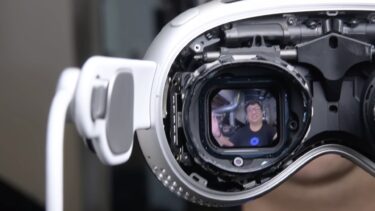iFixit takes a microscopic look at Vision Pro's displays

In the second part of the teardown, iFixit examines the Apple Vision Pro's impressive displays.
In the first part, iFixit examined how EyeSight works. This unique Vision Pro feature shows the user's eyes on the outward-facing display.
In the second part, the iFixit technicians turned their attention to the micro OLED displays and measured their properties with a digital microscope. They found the following:
- The diameter of a single pixel is 7.5 μm, the size of a red blood cell. This measurement is in line with Apple's specifications. According to this, approximately 54 Vision Pro pixels fit into a single iPhone 15 pixel.
- The lit panel area is approximately 27.5 mm wide by 24 mm high and consists of 3,660 by 3,200 pixels, or about 12 million pixels per panel.
- The cut-off corners of the panels account for approximately 5.3 percent of the surface area, leaving approximately 11.4 million pixels per panel visible. This is roughly equivalent to the 23 million pixels Apple claims for both displays.
- The calculated PPI is 3,386. For comparison: The Meta Quest 3 has 1218 PPI.
- The estimated PPD is 34 with a rough measurement of 100° field of view. For comparison: A 4K TV at 6.5 feet has about 95 PPD, and an iPhone 15 Pro Max at 1 foot has about 94 PPD.
Apple Vision Pro has a very high PPI. The relatively low PPD can be explained by the fact that the displays are very close to the eye.
The iFixit technicians also opened the external battery and found that it consists of three iPhone type batteries stacked on top of each other. The battery also has built-in temperature sensors and an accelerometer, probably to make the charging LED light up when the battery is held up.
The charging cable connects to the battery via a proprietary 12-pin Lightning connector. This is Apple's way of ensuring that you do not charge Vision Pro with another, unsuitable power adapter and accidentally damage the device.
Repairability: 4 out of 10 points
When it comes to repairability, iFixit sees pros and cons. One of the strengths is that the battery is modular and can be easily replaced (even if the Vision Pro shuts down because it does not support hot swapping). However, access to the batteries is difficult and leads to damage to the case.
The side arms are also easy to remove. The same applies to the light seal and face pad, which are attached with a magnetic holder, as well as the ZEISS lens inserts.
One of iFixit's repairability drawbacks is that the glass cover is difficult to remove. This, in turn, is necessary to gain access to the cameras and sensors.
The website gives 4 out of 10 points on the repairability scale. Further analysis is to follow.
- Vision Pro Teardown-Why Those Fake Eyes Look So Weird
- Vision Pro Teardown Part 2: What's the Display Resolution?
Note: Links to online stores in articles can be so-called affiliate links. If you buy through this link, MIXED receives a commission from the provider. For you the price does not change.